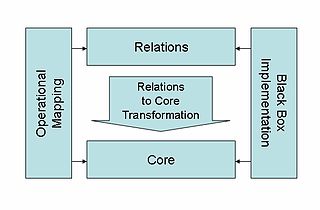In computer science, static program analysis is the analysis of computer programs performed without executing them, in contrast with dynamic program analysis, which is performed on programs during their execution.

Eclipse is an integrated development environment (IDE) used in computer programming. It contains a base workspace and an extensible plug-in system for customizing the environment. It is the second-most-popular IDE for Java development, and, until 2016, was the most popular. Eclipse is written mostly in Java and its primary use is for developing Java applications, but it may also be used to develop applications in other programming languages via plug-ins, including Ada, ABAP, C, C++, C#, Clojure, COBOL, D, Erlang, Fortran, Groovy, Haskell, JavaScript, Julia, Lasso, Lua, NATURAL, Perl, PHP, Prolog, Python, R, Ruby, Rust, Scala, and Scheme. It can also be used to develop documents with LaTeX and packages for the software Mathematica. Development environments include the Eclipse Java development tools (JDT) for Java and Scala, Eclipse CDT for C/C++, and Eclipse PDT for PHP, among others.
Model Driven Architecture (MDA) is a software design approach for the development of software systems. It provides a set of guidelines for the structuring of specifications, which are expressed as models. Model Driven Architecture is a kind of domain engineering, and supports model-driven engineering of software systems. It was launched by the Object Management Group (OMG) in 2001.

Simulink is a MATLAB-based graphical programming environment for modeling, simulating and analyzing multidomain dynamical systems. Its primary interface is a graphical block diagramming tool and a customizable set of block libraries. It offers tight integration with the rest of the MATLAB environment and can either drive MATLAB or be scripted from it. Simulink is widely used in automatic control and digital signal processing for multidomain simulation and model-based design.
I-Logix was a leading provider of Collaborative Model driven development (MDD) solutions for systems design through software development focused on real-time embedded applications. Founded in 1987, the Andover, Massachusetts-based company product line enhanced collaboration among engineers, graphically modeling the requirements, behavior, and functionality of embedded systems. In addition, I-Logix was a member of the UML Partners, a group devoted to the development of the Unified Modeling Language (UML).
Model-driven engineering (MDE) is a software development methodology that focuses on creating and exploiting domain models, which are conceptual models of all the topics related to a specific problem. Hence, it highlights and aims at abstract representations of the knowledge and activities that govern a particular application domain, rather than the computing concepts.

QVT (Query/View/Transformation) is a standard set of languages for model transformation defined by the Object Management Group.

The systems modeling language (SysML) is a general-purpose modeling language for systems engineering applications. It supports the specification, analysis, design, verification and validation of a broad range of systems and systems-of-systems.

Eclipse Modeling Framework (EMF) is an Eclipse-based modeling framework and code generation facility for building tools and other applications based on a structured data model.
Modeling and Analysis of Real Time and Embedded systems also known as MARTE is the OMG standard for modeling real-time and embedded applications with UML2.

Papyrus is an open-source UML 2 tool based on Eclipse and licensed under the EPL. It has been developed by the Laboratory of Model Driven Engineering for Embedded Systems (LISE) which is a part of the French Alternative Energies and Atomic Energy Commission (CEA-List).

DAVE (Infineon) Digital Application Virtual Engineer (DAVE), is a C/C++-language software development and code generation tool for microcontroller applications. DAVE is a standalone system with automatic code generation modules. It is suited for the development of software drivers for Infineon microcontrollers and aids the developer with automatically created C-level templates and user-desired functionalities.

RIF/ReqIF is an XML file format that can be used to exchange requirements, along with its associated metadata, between software tools from different vendors. The requirements exchange format also defines a workflow for transmitting the status of requirements between partners. Although developed in the automotive industry, ReqIF is suitable for lossless exchange of requirements in any industry.

Modelio is an open-source UML tool developed by Modeliosoft, based in Paris, France. It supports the UML2 and BPMN standards.
Cantata++, or simply Cantata in newer versions, is a commercial computer program for dynamic testing, specifically unit testing and integration testing, and code coverage at run time of C and C++ programs. It is developed and sold by QA Systems, and was formerly a product of IPL Information Processing Ltd.

Sparx Systems Enterprise Architect is a visual modeling and design tool based on the OMG UML. The platform supports: the design and construction of software systems; modeling business processes; and modeling industry based domains. It is used by businesses and organizations to not only model the architecture of their systems, but to process the implementation of these models across the full application development life-cycle.
itemis AG, headquartered in Lünen, is a German IT consulting and software development company, active among other things in the field of model-driven software development (MDSD). With the YAKINDU product family, itemis sells a number of self-developed software products.










